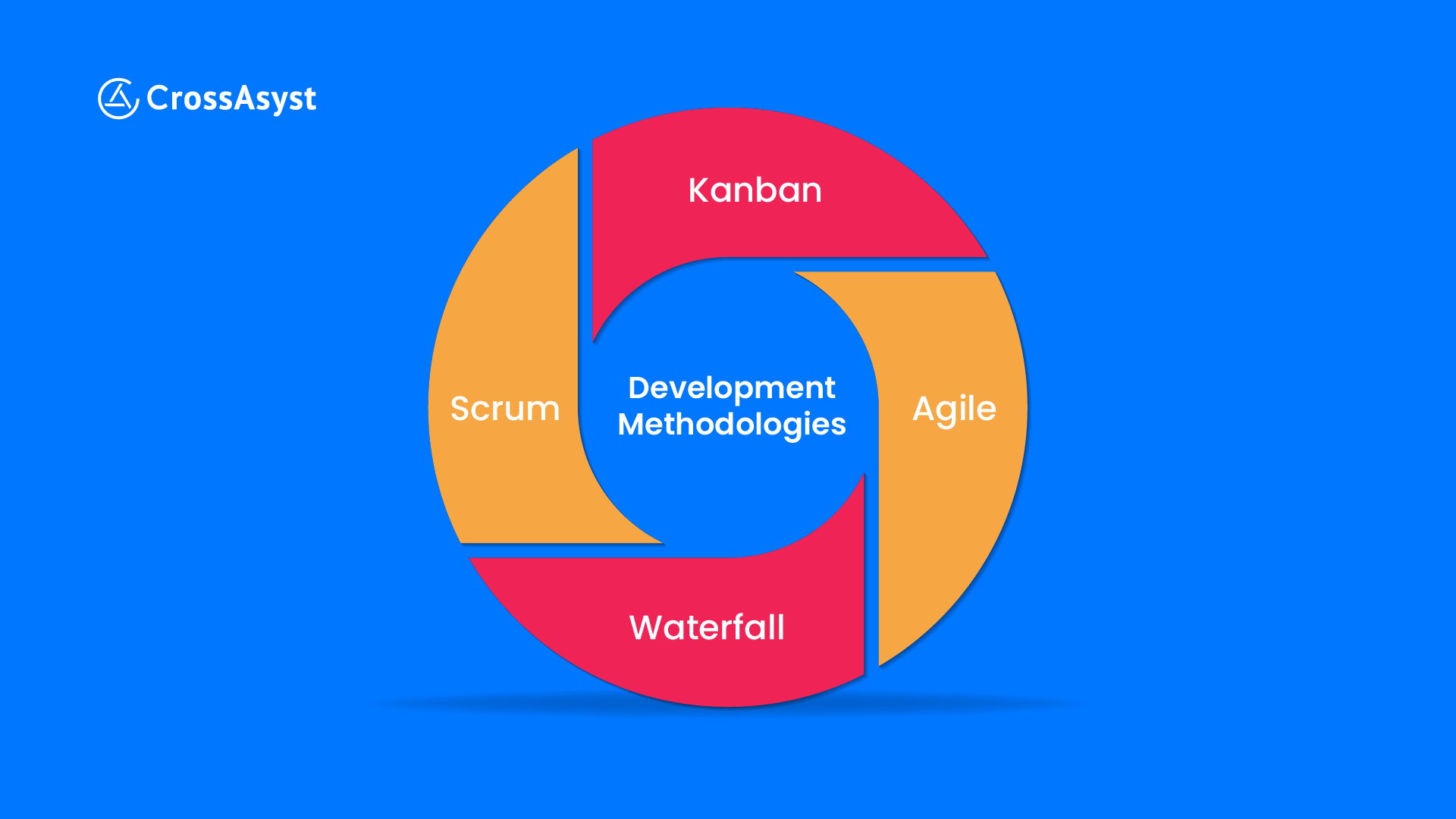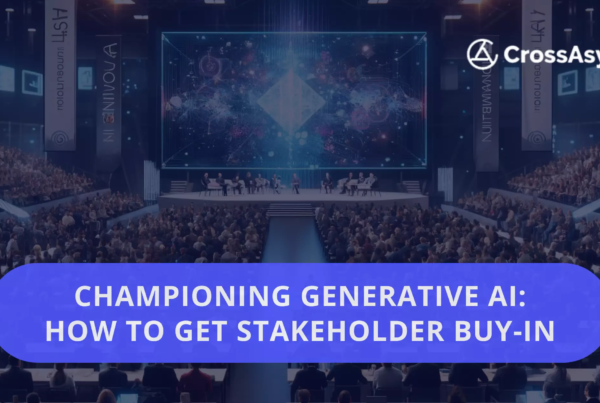If you want to build a new software solution, one of the most important factors you need to consider is the software methodology that best suits the scope of the project. However, to make that choice, you first need to understand the differences between different development methodologies.
Here’s a comparative study between four popular software development methodologies: Agile, Waterfall, Scrum, and Kanban.
Table of Contents
Software Development Methodologies and How They Work
Before delving into the specifics, let’s understand what software development methodologies are and how they work.
Software development methodology is a systematic approach to software development that provides a framework for planning, structuring, and controlling the process of developing information systems. It outlines the steps, activities, and tasks required to build high-quality software products.
A Look at the 4 Different Development Methodologies
Let’s now dive into the 4 different software development methodologies we are going to compare today.
Agile Methodology
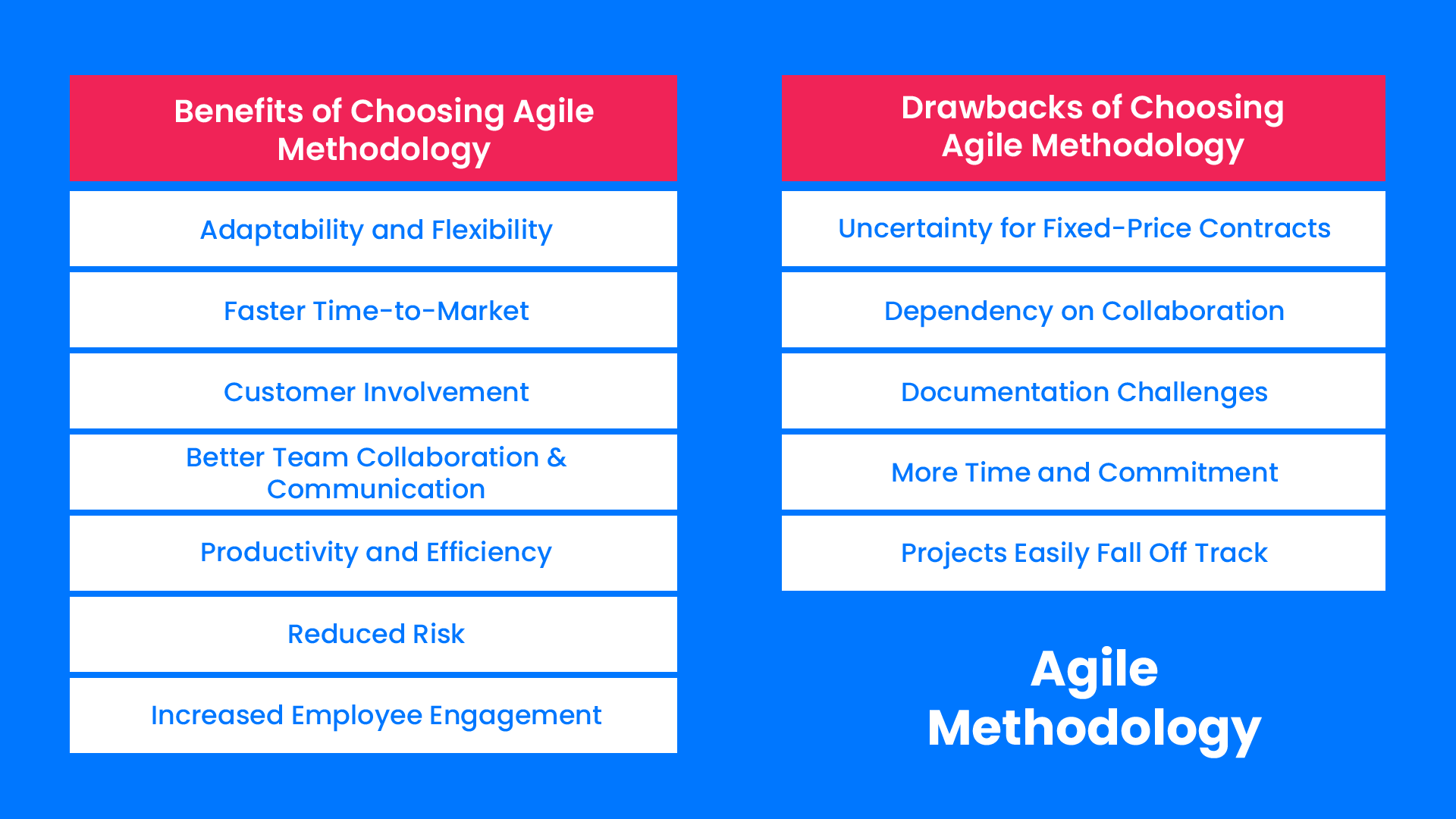
Agile methodology is a flexible and iterative approach to software development that prioritizes adaptability, collaboration, and customer feedback. It is characterized by its ability to respond to changing requirements even late in the development process, allowing teams to deliver valuable features incrementally.
Here are some key benefits and drawbacks associated with choosing Agile methodology:
Benefits of Choosing Agile Methodology
- Adaptability and Flexibility: Agile’s strength lies in its ability to accommodate changes, making it suitable for projects with evolving requirements.
- Faster Time-to-Market: The incremental nature of Agile allows for quicker releases, ensuring that valuable features reach users sooner.
- Customer Involvement: Agile encourages continuous customer feedback throughout the development cycle, ensuring the end product aligns with user expectations.
- Better Team Collaboration & Communication: Agile promotes regular communication and collaboration within cross-functional teams, fostering a cohesive working environment.
- Productivity and Efficiency: The iterative development process in Agile leads to improved efficiency and higher productivity as teams continuously refine and enhance their work.
- Reduced Risk: The incremental approach of Agile minimizes the impact of potential failures, allowing for early detection and correction of issues.
- Increased Employee Engagement: Agile empowers team members by fostering a sense of ownership and engagement, contributing to a more motivated and productive workforce.
Drawbacks of Choosing the Agile Methodology
However, Agile comes with its own set of challenges.
- Uncertainty for Fixed-Price Contracts: Fixed budgets may pose challenges in Agile projects due to the iterative and evolving nature of the development process.
- Dependency on Collaboration: Success in Agile relies heavily on effective collaboration, and any breakdown in communication or teamwork can be detrimental.
- Documentation Challenges: Agile’s emphasis on working software sometimes leads to inadequate documentation, which may pose challenges to maintaining a comprehensive project record.
- More Time and Commitment: Agile demands continuous involvement from team members, potentially requiring more time and commitment compared to other methodologies.
- Projects Easily Fall Off Track: The lack of a rigid structure in Agile may lead to projects deviating from the original plan, requiring careful management to stay on course.
Waterfall Methodology
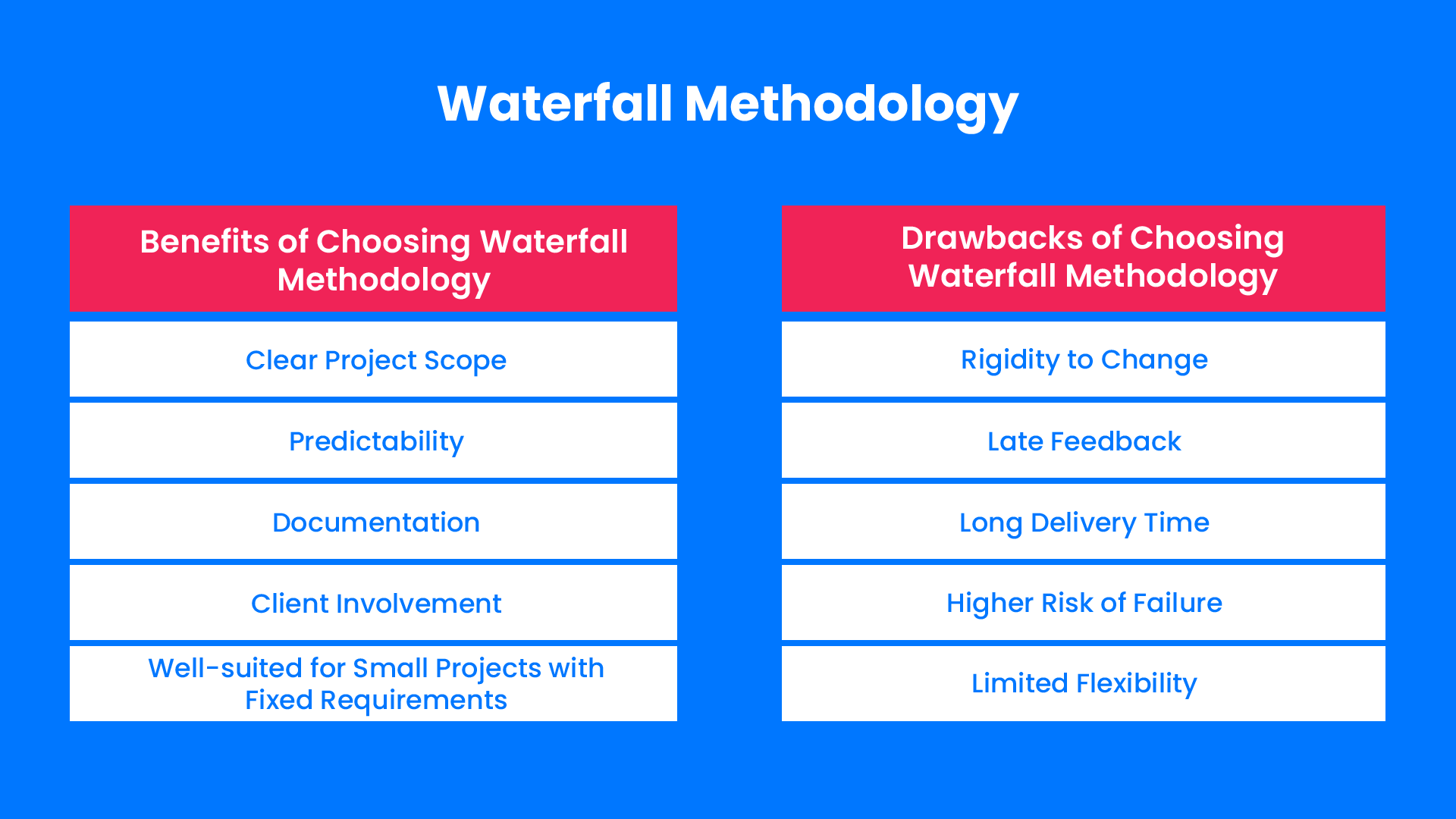
Waterfall methodology is a traditional and linear approach to software development, where the project is divided into sequential phases, and each phase must be completed before moving on to the next. This structured method is characterized by a well-defined process that progresses through distinct stages, making it particularly suitable for projects with fixed requirements.
Let’s explore the benefits and drawbacks associated with choosing the Waterfall methodology:
Benefits of Choosing Waterfall Methodology
- Clear Project Scope: The well-defined phases in Waterfall ensure a clear project scope from the outset, providing a solid foundation for development.
- Predictability: Waterfall methodology offers predictable timelines and deliverables, making planning more straightforward for both the development team and stakeholders.
- Documentation: Thorough documentation is a hallmark of the Waterfall approach, ensuring a comprehensive record of the project’s progress and decisions.
- Client Involvement: Clients are involved at each phase of the Waterfall process, ensuring alignment with expectations and minimizing misunderstandings.
- Well-suited for Small Projects with Fixed Requirements: Waterfall is particularly well-suited for simple projects with fixed requirements, where a sequential and structured approach is beneficial.
Drawbacks of Choosing Waterfall Methodology
Despite its advantages, Waterfall comes with certain limitations.
- Rigidity to Change: Any changes requested after the initial phase can be challenging to implement in Waterfall, as the entire development process is sequential.
- Late Feedback: Feedback from stakeholders comes late in the process, potentially leading to costly corrections or adjustments.
- Long Delivery Time: The sequential nature of Waterfall extends the time needed to deliver the final product, which may be a disadvantage in rapidly evolving industries.
- Higher Risk of Failure: Comprehensive planning in the early stages may not account for unforeseen challenges, leading to a higher risk of failure if issues arise later in the project.
- Limited Flexibility: Adaptability to changes during the development process is limited, making Waterfall less suitable for projects where requirements may evolve.
Scrum Methodology

Scrum, a widely adopted Agile framework, revolutionizes the software development process by emphasizing collaboration, transparency, and adaptability. It operates under the Agile umbrella, offering a structured yet flexible approach to project management. Before delving into the benefits and drawbacks of Scrum, let’s briefly understand what Scrum methodology entails.
Scrum divides the project into short development cycles called sprints, typically lasting two to four weeks. It promotes iterative progress, regular reassessment, and continuous improvement. Cross-functional teams work collaboratively to deliver high-value features in each sprint, ensuring a product that aligns closely with customer needs.
Benefits of Choosing Scrum Methodology
- Adaptability and Flexibility: Similar to Agile, Scrum allows for adaptability to changing requirements, providing a responsive framework for dynamic projects.
- Increased Collaboration: Cross-functional teams collaborate closely throughout the project, fostering effective communication and teamwork.
- Customer Satisfaction: Regular reviews and feedback loops ensure customer satisfaction by incorporating user input at various stages of development.
- Improved Transparency: Scrum enhances transparency through regular team meetings and updates, keeping all stakeholders informed about project progress.
- Focus on Value Delivery: Scrum places a strong emphasis on delivering value to the customer, ensuring that each sprint contributes meaningfully to the project’s overall goals.
Drawbacks of Choosing Scrum Methodology
However, Scrum comes with its own set of challenges.
- Learning Curve: Adopting Scrum may require time for teams to become proficient in the methodology, potentially affecting initial project efficiency.
- Fixed Timeframes: Fixed sprint durations, while providing structure, can be limiting for certain projects, especially those with evolving requirements.
- Dependency on Team Collaboration: The success of Scrum relies heavily on effective collaboration within the team. Any communication breakdown can impact project outcomes.
- Limited Scope for Small Projects: Scrum’s comprehensive framework may be overkill for smaller projects, where a more lightweight approach might be sufficient.
- Requires Active Stakeholder Involvement: Stakeholder engagement is critical for Scrum to be effective. Lack of involvement can lead to misunderstandings and project delays.
Kanban Methodology
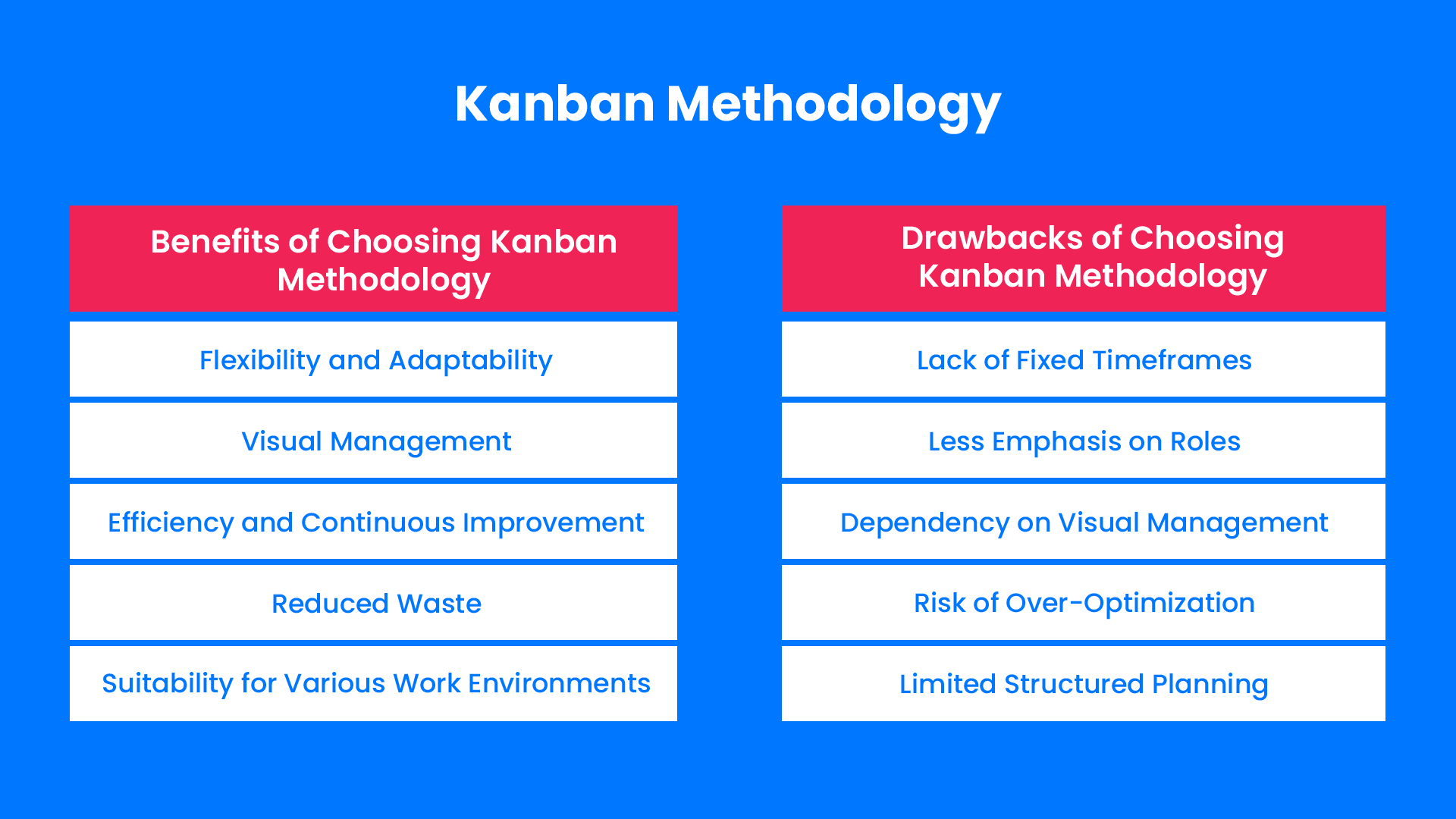
Kanban utilizes visual boards, often in the form of Kanban boards, to provide a clear representation of the workflow. Work items are visualized as cards, moving through different stages of the process.
Work-in-progress (WIP) limits help maintain a balanced workflow, preventing bottlenecks and overloading teams. Kanban’s focus on continuous improvement and adaptability makes it suitable for various work environments.
Benefits of Choosing Kanban Methodology
- Flexibility and Adaptability: Kanban’s continuous flow model allows for flexibility and adaptability to changing priorities, making it well-suited for dynamic projects.
- Visual Management: Kanban boards and work-in-progress limits offer a clear visual representation of the work, enhancing transparency and team collaboration.
- Efficiency and Continuous Improvement: Kanban emphasizes efficiency through the continuous improvement of processes, making it a dynamic methodology that evolves over time.
- Reduced Waste: Kanban aims to minimize waste in the development process by optimizing workflow and eliminating unnecessary tasks.
- Suitability for Various Work Environments: Applicable across industries, Kanban is easy to adopt, making it a versatile choice for different types of projects. Source
Drawbacks of Choosing Kanban Methodology
However, Kanban has its considerations and potential challenges.
- Lack of Fixed Timeframes: The absence of fixed iterations in Kanban can make planning challenging, particularly for projects that require a more structured timeline.
- Less Emphasis on Roles: Kanban has fewer defined roles compared to other methodologies, potentially leading to ambiguity in team responsibilities.
- Dependency on Visual Management: Success in Kanban relies heavily on the effectiveness of visual management. Inadequate visualization may hinder the smooth flow of work.
- Risk of Over-Optimization: Constant optimization in Kanban may lead to overlooking the bigger picture, potentially sacrificing long-term goals for short-term gains.
- Limited Structured Planning: Kanban may not be ideal for projects requiring highly structured planning, where a more defined methodology could be more appropriate. Source
Quick Comparisons
Here are some quick comparisons between these software development methodologies.
Agile Vs Waterfall
| Criteria | Agile | Waterfall |
| Approach | Iterative and flexible | Sequential and rigid |
| Project Phases | Short sprints with continuous delivery | Sequential phases with defined milestones |
| Flexibility | Emphasizes adaptability to change | Limited flexibility |
| Planning | Quick adaptation to changing requirements | Prior planning with well defined project plan |
| Risk | Low risk due to adaptability | Increased project risk due to due to lack of flexibility |
| Customer Involvement | High rate of involvement | Low rate of involvement |
| Documentation | Higher focus on product function than documentation | High focus on clear documentation |
Agile Vs Scrum
| Criteria | Agile | Scrum |
| Framework type | General iterative methodology | Special Agile framework with roles and rituals |
| Sprints | Short development cycles | Time-boxed sprints |
| Roles | No specific roles are enforced | Specific roles such as Scrum master, Product owner, Team, etc. |
| Structure | No rigid structure | Clearly define roles and responsibilities |
| Continuous Improvement | Embraces the mindset of continuous improvement | Focuses on continuous improvement though sprints |
Agile Vs Kanban
| Criteria | Agile | Kanban |
| Framework type | General iterative methodology | Agile subset, visualizes tasks on a board |
| Views | Can use multiple project management views | Uses Kanban boards for views |
| Columns | Flexibility in board columns | Columns represent stages of work |
| Time-bound | Emphasis on short sprints | Flexible work stages |
| Adaptability | Quickly adaptable to changes | Flexible framework for dynamic processes |
| Project types | Suitable for all kinds of projects | Best suited for ongoing projects |
Choosing the Best Software Development Methodology
- Prioritize project goals: Understand what your project values most. If you need flexibility to adapt to changes and feedback quickly, Agile methodologies like Scrum or Kanban are beneficial. On the other hand, if your project requires strict adherence to deadlines and budget constraints, the structured approach of Waterfall may be more suitable.
- Consider client preferences: Take into account your client’s expectations and working style. Agile frameworks, such as Scrum, are ideal if your client prefers frequent updates and the ability to adjust requirements throughout the project. In contrast, Waterfall may be preferred for clients who prefer a clear, predefined plan from the outset with minimal changes.
- Evaluate project scope: Assess the size, complexity, and predictability of your project. Agile methodologies excel in dynamic environments where requirements evolve over time. Scrum works well for projects with a clear, achievable goal within shorter time frames, typically a few weeks. Conversely, Waterfall is suited for projects with well-defined, stable requirements and a longer-term timeline.
- Manage budget effectively: Consider your budgetary constraints and resource availability. Agile methodologies can be more cost-effective due to their iterative approach, allowing for adjustments without substantial rework. Waterfall, with its sequential nature, may require more upfront planning and budget allocation but can provide clarity on project costs from the outset.
- Define project cycles: Determine the duration and structure of your project cycles. Agile frameworks, such as Scrum, operate in short, iterative cycles (sprints) that promote continuous improvement and responsiveness to change. This is beneficial for projects where rapid delivery of incremental improvements is crucial. In contrast, Waterfall divides the project into distinct phases (requirements, design, development, testing, deployment) with clearly defined milestones and deliverables, making it suitable for projects with a linear, predictable timeline.
Contact us to learn more about what makes us a globally preferred custom software development company.
